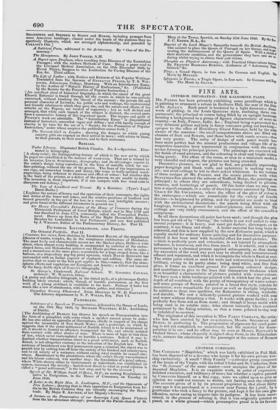FINE ARTS.
INTERIOR DECORATION THE KALSOMINE PAINT,
Mn. PARRIS has been privately exhibiting some panellings which it is painting to ornament a saloon in Redburn Hall, the seat of the Duke of ST. ALBAN'S. Each panel is bordered by a light decorative frame. work of gilding, in the Louis Quatorze style, enclosing three com. partments; the principal or centre being filled by an upright landscape, forming a background to a group of figures characteristic of smile ore country—as Italy, France, India, 84c.; England being represented by I very debonair gallant and lady in fancy costumes going out hawking,— apropos to the office of Hereditary Grand Falconer, held by the noble owner of the mansion : the small compartments above are filled with clusters of fruit and flowers, and those below with rustic scenes—these last very pretty. The unity of design of each panel -would have been more perfect had the natural productions and village life of the respective countries been represented in conjunction with the courtly scenes forming the principal picture. The paintings arc executed with • the finish of easel-pictures, and the colouring is clear and bright without • being gaudy. The effect of the room, as seen in a miniature model, is very cheerful and elegant, the pictures not being crowded. Decorative pictures, we are glad to find, are gradually superseding paper-hangings and blank walls, and upholstery is malting way for . art : nor must ceilings lie left in their naked whiteness. In the instance of these designs of Mr. PARRIS, and the scenic pictures with which STAN FIELD has adorned the saloons of Stafford House, the paintings are principal ; in others they are subordinate, being limited to pilasters, cornices, and borderings of panels. Of this latter class we may men- tion a superb example, in a suite of drawing-rooms executed by Messrs. CRACK for Mr. COCKERELL, where the effect of the glow of colour in the arabesques—which are remarkable fbr the variety of fanciful devices—is heightened by gilding, and the pictorial are made to blend with the architectural decorations ; the panels being filled with silk hangings, forming a ground for cabinet-pictures, and mirrors. The ceilings are very richly ornamented, and the effect of the ensemble is sumptuous.- In all these decorations oil-paint has been used; and though the gloss ' has been got rid of by "flatting," the vehicle is not well suited to orna- mental purposes : it is heavy, and must get darker ; distemper, on the contrary, is too flimsy and crude. A better material has long been de- siderated, and this is now supplied by the new Kalsomine paint, which is equally useful for ordinary house-painting and for decorative purposes: indeed it has been used with beautiful effect for easel-pictures. The vehicle is perfectly pure and colourless, is not injured by atmospheric influence, is innocuous, and free from smell. It is soluble, and is made permanent by a chemical process applied subsequently, so that during the execution of' the work any part may be cleanly and instantaneously effaced and repainted, and when it is complete the whole is fixed at once. The white paint which is used for walls and wainscoting is remarkably brilliant, owing to its purity alone: being dead white, and free from gloss, it forms an excellent ground for painting coloured designs, and contributes to give to the hues that transparent freshness wrack is so beautiful a characteristic of pictures painted with water-colours. We have seen a little landscape painted with it, which had the glow and depth of oil combined with the purity of transparency of water-colour; and some groups of flowers, painted in a broad free Style, suitable for decoration, were remarkable for power as well as daylight brightness. In addition to these rare qualities, the Kalsomine is cheap, washable, and durable. We saw a delicately-painted picture washed with soap and water without disturbing a tint. It works with great facility ; is as perfectly free front soil as from scent ; and though it keeps moist while being used in its soluble state, dries almost instantly when rendered permanent by the fixing solution, so that a room painted to-day may be inhabited to-morrow.
The originator of this invention is Miss FANNY CORBAUX, the artist; who has been assisted by her co-patentees, Messrs. SPILSRURY and BYRNE, in perfecting it. The preparation of pigments for easel-paint- ing is not yet completed, we understand, but the material for house' paintin"• is in use : and its effect may lie T e seen at Messrs. BATAN 's in Oxford'Street ; whose elegantly designed shop. front, in the Elizabethan style, attracts the admiration of the passenger at the corner of Berners Street.


























 Previous page
Previous page